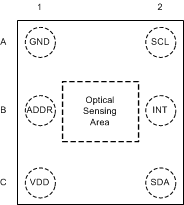ZHCSFL9 October 2016 OPT3006
PRODUCTION DATA.
- 1 特性
- 2 应用
- 3 说明
- 4 修订历史记录
- 5 Pin Configuration and Functions
- 6 Specifications
-
7 Detailed Description
- 7.1 Overview
- 7.2 Functional Block Diagram
- 7.3 Feature Description
- 7.4 Device Functional Modes
- 7.5 Programming
- 7.6
Register Maps
- 7.6.1
Internal Registers
- 7.6.1.1
Register Descriptions
- 7.6.1.1.1 Result Register (offset = 00h)
- 7.6.1.1.2 Configuration Register (offset = 01h) [reset = C810h]
- 7.6.1.1.3 Low-Limit Register (offset = 02h) [reset = C0000h]
- 7.6.1.1.4 High-Limit Register (offset = 03h) [reset = BFFFh]
- 7.6.1.1.5 Manufacturer ID Register (offset = 7Eh) [reset = 5449h]
- 7.6.1.1.6 Device ID Register (offset = 7Fh) [reset = 3001h]
- 7.6.1.1
Register Descriptions
- 7.6.1
Internal Registers
- 8 Application and Implementation
- 9 Power-Supply Recommendations
- 10Layout
- 11器件和文档支持
- 12机械、封装和可订购信息
5 Pin Configuration and Functions
YMF Package
6-Pin PicoStar
Top View

Pin Functions
| PIN | I/O | DESCRIPTION | |
|---|---|---|---|
| NO. | NAME | ||
| A1 | GND | Power | Ground |
| B1 | ADDR | Digital input | Address pin. This pin sets the LSBs of the I2C address. |
| C1 | VDD | Power | Device power. Connect to a 1.6-V to 3.6-V supply. |
| A2 | SCL | Digital input | I2C clock. Connect with a 10-kΩ resistor to a 1.6-V to 5.5-V supply. |
| B2 | INT | Digital output | Interrupt output open-drain. Connect with a 10-kΩ resistor to a 1.6-V to 5.5-V supply. |
| C2 | SDA | Digital input/output | I2C data. Connect with a 10-kΩ resistor to a 1.6-V to 5.5-V supply. |